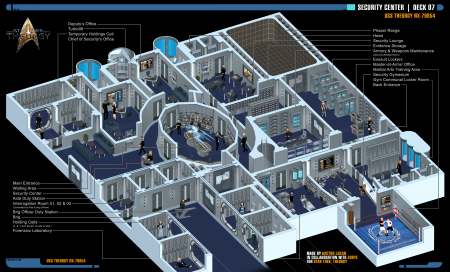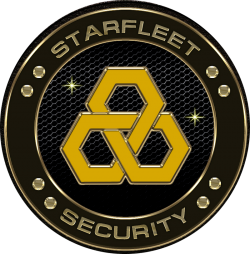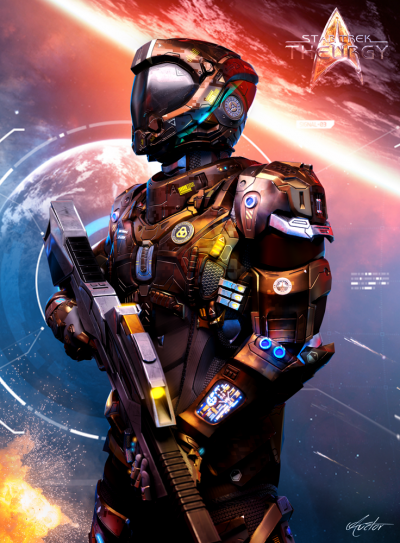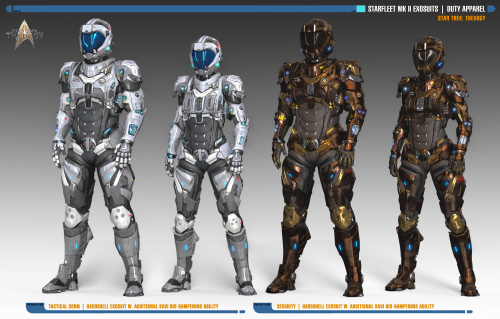Security
From Star Trek: Theurgy Wiki
Starfleet Security was one of the oldest institutions with its origins dating back to Earth Starfleet, responsible for safeguarding the Federation from internal and external threats, for conducting criminal investigations, and for guarding Federation facilities. [Source: Memory Alpha]
Starfleet Security was also the armed special forces of the fleet. Duties ranged from putting yourself between a phaser and the Commanding Officer of the ship, patrolling the ship for endless hours, and even engaging hostile threats upon uncharted planetoids.
To be a member of Starfleet Security, one needed the ability to foresee a problem and avert it, and think on one's feet to figure out a decisive, effective solution to the situation at hand. A Security Officer had to have an understanding of the scenario and the people involved, knowing the problem s/he was dealing with inside and out. S/he needed to be prepared to use force to neutralize any and every threat, but only use it as a last resort. S/he was protective of the ship and crew, and was required to defend both to their last breath.
Mission Status
This segment describes the current situation aboard the Theurgy.
UNDER CONSTRUCTION
Positions
(Under Construction) As of 2381, these were the different roles in this department:
| Security Roles | |
|---|---|
| Role | Description |
| Chief Security Officer |
WIP |
| Deputy Chief Security Officer |
The Deputy Chief Security Officer was the second senior most Security Officer aboard and reported directly to the Chief Security Officer. |
| Master-at-Arms |
WIP |
| Security Officer |
WIP |
| Investigations Officer |
WIP |
| Combat Medic |
WIP |
Standing Orders

All Security Officers were at all times responsible for carrying out standing orders. Standing orders were permanent, unless cancelled by the CSec.
Aims & Directives
- To preserve the integrity of the ship against intrusion and insurrection.
- To provide protection for landing parties entering unexplored or hazardous territory.
- To act in concert with Damage Control and Medical personnel in seeking out and rescuing personnel trapped in hazardous areas or missing in action.
- To ensure the safety of visiting dignitaries.
- To provide armed escort for Flag and Senior Officers venturing into hazardous territory.
- To serve as an honour guard as designated.
- To ensure the integrity of restricted areas of the ship against entry by unauthorized personnel.
- To provide a first-line strike force for boarding hostile vessels.
- To oversee transfer and/or confinement of persons under legal arrest or in custody.
- To act as bailiffs for onboard legal proceedings.
- To oversee the safe and orderly proceedings of any partial evacuation of the ship, or to aid in the full abandonment of the ship.
- To serve as a rescue force for any crewmember or citizen of the United Federation of Planets who was incarcerated or held hostage illegally by any hostile power and/or government.
- To effectively intervene in intra-crew disputes, or in disputes between crew members and civilians.
- To ensure the observance of applicable Starfleet Directives by civilian personnel on Starfleet vessels or facilities.
- To ensure peaceful contact by all parties in Starfleet and Federation supervised negotiations
- To maintain alertness at post or duties until such time as relieved by qualified personnel.
Duties & Responsibilities
- To obey all directions and orders given by the Ship's Commanding Officer, Executive Officer, Second Officer, the Chief of Security, the Deputy Chief of Security, and other line officers of higher than Ensign rank, in that descending order.
- To work smoothly and efficiently with assigned officers on your duty shift.
- To avoid the consumption of any substance of a mood-altering nature during a period of 8 hours before scheduled to go on-duty.
- Weapons shall be worn at all times while on duty.
- Weapons shall be set on Medium Stun unless otherwise ordered by an officer in the line of command, or unless the ship is on Condition 4, or unless special circumstances pertain making Medium Stun ineffectual or undesirable.
- In hazardous territory or under perilous circumstances, weapons shall be drawn or be ready to be drawn at all times.
- Under normal circumstances, weapons shall not be drawn unless danger to life or limb is apparent an imminent.
- If a weapon is damaged or lost, the fact must be passed to the Master-at-Arms at once.
During Sentry & Patrol Duties
- To take charge of the assigned post and all areas in view.
- To guard the post in a military manner, keeping always on the alert and observant of everything.
- To report all violations of Special or Standing Orders.
- To maintain communication with the aide in the Security Office.
- To receive, obey, and pass on to other relieving personnel any Special Orders received by the CSec or Deputy.
- To talk to no one except in the line of duty.
- To sound the alert in case of danger or disorder.
- To call the Csec or Deputy in any case not covered by instructions.
Brief Duty Protocols
There were three types of duties a Security Officer undertook - General Duties, Special Duties, and Ceremonial Duties.
General Duties
Patrol: A Security Officer or team of two patrolled throughout the ship. They received their routes from the CSec or Deputy at the beginning of their shift, in the Security Office. This route was computer generated, striving for both random pattern and minimum redundancy. There were two basic reasons for this; it reduced the element of boredom inherent in the nature of patrolling (and thus minimized errors caused by fatigue), and it eliminated the possibility of a spy or saboteur scheduling his activities safely according to an observed pattern. A regular check-in with the Aide in the Security Office was required every 15 minutes.
If a suspicious circumstance was observed, one was required to contact the Csec or Deputy first before taking action. Phaser was then drawn, setting checked, and one approached quietly and cautiously. If there were two Security Officers, one would move in, and one would cover him. On final approach to the suspicious area, the unofficial rule of patrols: "Shoot first and apologize later" was remembered. A phaser set on Medium Stun couldn't cause permanent injury, and it was better to be safe than sorry. It was preferable that an innocent officer or crewman take an unscheduled nap than the safety of the entire vessel be endangered. Otherwise, the "Sentry & Patrol Duties" above should be reviewed.
Armoury: The Armoury was the Master-at-Arms' domain. Here was where the Master-at-Arms trained and supervised Security personnel in departmental operations, repairs, and protocols. S/he supervised weapons locker access and phaser pistol and rifle deployment, along with noting and tagging those in need of repair. S/he was also qualified to temporarily act as Chief of Security if so ordered. The Master-at-Arms otherwise reported to the Chief of Security and Deputy Chief of Security.
If you had a duty shift in the Armoury, then you were responsible for repairing any weapons which had been damaged and administering records. You could also assist the Master-at-Arms in the training of other Security personnel.
Special Duties
Investigation: Fulfilled the role of a special investigator or detective when dealing with Starfleet matters aboard ship or on a planet. Coordinated with the Chief of Security on all investigations as needed. During an investigation, the Security Officer reported to the Chief of Security.
Away Team: One or more Security Officers usually accompanied any parties into unknown territory.
Scouting Party: An entire squad of Security Officers was usually deployed to scout dangerous or hazardous territory.
Boarding Party: An entire squad of Security Officers was usually the first to beam aboard captured or uncommunicative vessels. Upon establishing that there was no danger or that the situation was under control, they signaled the all clear to the ship, so other personnel could follow.
Brig/Prisoner: If a prisoner was to be interned, the CSec or Deputy would assign a guard. This could be in the Brig, in Sickbay, or in the prisoner's own cabin. The guard would remain with the prisoner until relieved by his replacement, the CSec, Deputy, Executive Officer, or the Commanding Officer.
Locking: On orders of the CSec, Deputy, Xo or CO, a Security Officer would be dispatched to a given compartment to apply Seal Monitors to all doors. Seals could be obtained in the Armoury. See "Sealed Compartments" below.
Arrest: On orders of the CSec or Deputy, a security detail would be dispatched to a given location to physically arrest an individual and conduct him to the Brig, Sickbay, or his quarters as deemed by the officer giving the order.
Sentry: On the orders of the CSec, a security detail would be posted to a particular station or doorway and there advised of further duties. Otherwise, review "Sentry & Patrol Duties" above.
Search: There were two types; Missing Personnel were searched for by a full deck-by-deck search of the ship by a squad of Security Officers. Security personnel in space suits examined the exterior of ship and the surrounding space. Sickbay would standby to receive the injured person. During Intruder Alert, the possible intruders were searched for by a full deck-by-deck security sweep, with isolation forcefields activated, and all Security Officers aboard brought into active duty.
Abandon Ship: On the order of the commanding officer, all Security personnel assumed their pre-arranged Evacuation duties.
Ceremonial Duties
Bodyguard: A Security Officer could be assigned to act as guide for a VIP while the latter visited aboard the ship. The Security Officer escorted the VIP wherever they wished to go, except for restricted or controlled areas. When the VIP returned to his quarters, the Security Officer reported to the Security Office and requested to be relieved.
Escort: A Security Officer could be assigned to act as guide for a visiting Flag Officer aboard the ship, or as escort to one of his own ship's officers on another ship, or on a planet. Number and armament depended on the situation, or as assessed by the CSec or Deputy.
Honour Guard: When a VIP came aboard, an honour guard was deployed to the Airlock, Transporter Room, or Flight Deck to greet him as a measure of respect. If the VIP was the representative of a planetary government, he would be accorded 'Presidential Honours' and the anthem of his planet played. If the VIP was a Flag Officer, he was piped aboard.
Security Officer Host: During a banquet or celebration aboard ship, with Non-Starfleet persons attending, Security personnel were sometimes assigned to attend the function. They wore concealed Type-I hand phasers.
Security Exosuit
In the wake of the Dominion War, Starfleet R&D evaluators had discovered that standard-issue EVA suits were decidedly lacking in the capabilities necessary to fulfill operations of a more threatening kind. Simply put, they were ill-suited to a combat role. As such, several programs and options as a supplemental replacement were presented and explored, but none were official adopted. That is until early phases of the then newly instituted Tactical CONN Exosuit Program. Project directors involved in that program had theorized about a wider multitude of applications for the design, and after a proposal was drawn up, and concepts completed, the Security-class exosuit was born.
The Security-class exosuit was a low-profile EVA design, intended for use by Starfleet Security and Marine personnel engaged in operations which took place in high-thread environments, particularly under toxic, radiological, and or hard vacuum conditions. It's basic frame was similar to that of the Tactical CONN-class exosuit; with adjustable-size exoskeletal limb and torso capabilities resultant from small overlapping sectional side plating, which dynamically expanded and contracted the overlap distance of its many outer plates, adapting to the wearer's limb length and girth. The plates also offered a varying degree of flexibility for its wearers, having moved in conjunction with body movements during general use.
After the USS Theurgy had arrived in dock at the Aldean Shipyards, and contact established with Rear Admiral Joseph Nerva Anderson; advanced variants of the Security and Tactical CONN classes of exosuit were uncovered via provided backdoor database access. The ships requisitions and Engineering department then went about the process of replacing all previous Mk I exosuits with this new improved Mk II design. Only a few Mk I exosuits were kept in service and storage, mostly for emergency necessity, while a majority were recycled through the replicator system.
The Mk II designs were composed of four layers: closest to the skin was a liquid heat insulation layer, next a pressure-restraint layer, then a micrometeoroid resistant layer which was reinforced with lightweight ablative ceramic sheeting, and lastly additional sectional dura-ceramic ablative armor plating for improved armor capacity. The role of the liquid head insulation later was to keep the wearer's body at a preferred/comfortable temperature. The pressure-restraint layer maintained appropriate internal air-pressure, and was intended to prevent atmosphere from escaping the suit; however, unlike the Tactical CONN-class exosuit, it only provided a fraction of the constriction capabilities which were requirement in order to more effectively serve as a G-Suit. This deliberate limitation was a result of the expectation that Security personnel were less likely to suffer the same high-acceleration stresses that Pilots were routinely subjected too, and allowed a percentile decrease in overall mass and volume of the suit, slightly improving the Security-class exosuit's overall flexibility. The primary outside layer protected its wearer from the extreme temperature changes one might experience in the multitude of environments that exist, cosmic dust particulates, and to a certain extent energy and projectile weapons fire. The final sectional layer covered more common vital-organ locations around the wearer's body and provided a more substantial capacity for weapons damage.
Interwoven into the structure of these exosuits was a synthetic muscular servomechanism and spinal stabilizer column. At the back of the exosuit were the primary pair of low-energy thrusters, which were designed for extended capacity. Additional low-energy thrusters were located in the magnetized hard-shell boots. Yet more small reaction-control thrusters were located throughout key-points of the design as well, allowing for a greater range of dexterous movement. The PM-1 locater beacon on the helmet was fitted with a xenon strobe, capable of generating 9,600 lumens for the sake of visibility during rescue operations. In Mk II designs, stand-alone life support systems would have provided a wearer with oxygen for sixteen-hours instead of the twelve-hour capacity of the previous Mk.I design. However, the exosuits were also outfitted with auxiliary oxygen support systems as a back-up to the primary system, offering an additional ten-hours of breathable atmosphere. Lastly, an emergency battery powered a O2 analyzer and carbon-dioxide scrubber could provide up to four-hours of a supply. All-in-all, the total life-support capacity of the Mk II exosuit measured in at around thirty-hours, a whole ten-hours longer than previous designs.
Utility compartments located at the hips and on the outer-sides of the legs often contained the following items:
- Magnetic-retaining thigh holster and ammunition container for Type-II Pulse Phaser Pistol and four additional power cells.
- Magnetic-retaining phaser grenade slots
- Hard-shell resealable containers for various items; Type-III Pulse Phaser Rifle power cells, flex-restraints, and other essential gear.
- 20cm retractable parsteel combat/utility Knife
Forearm PADDs
Whereas the PADD display read-out of the Mk I design of exosuit was a simplified version of the standard-issue Starfleet variety, the Mk II, and more specifically the Mk II designs employed aboard the USS Theurgy were slightly more complex. Melded with a degree of Savi technology as part of their exchange, these PADDs had granted a broader capacity for sensor-dampening, rendering its wearer near-undetectable by traditional and even some advanced sensor sweeps. Both PADDs were integrated into their respective forearms, and were used to a varying effect; generally however, the left-forearm PADD was programmed to display primary suit interface, recording critical navigational instructions, mission updates, communication code frequencies, and other pieces of vital information. During operations, a dedicated circuit could also record the wearer's biological data and serve to provide rapid diagnosis of injury. The right-forearm PADD was generally programmed to connect with a wearer's weapon read-out interface, allowing for better tactical awareness of the weapons' power-level, as well as easier re-modulation of weapon phase harmonics. Both also served as standard issue tricorders.
In the event that the exosuit's wearer was incapacitated, both PADDs would flash-erase all stored information to keep it from being compromised, sparing only biomedical subsystems; alternatively, the wearer could deliberately initiate this security measure with a simple encoded voice commander via his helmet.
Visor Display
The visor of the Security-class exosuit was vastly different from that of the TacCONN-class exosuit. For one thing, there was no need for a 'Through-Visor Display', and the mass and volume that would otherwise be used for that purpose was instead replaced with a number of sensor and short-range navigational system upgrades. The standard package granted low-light vision, as well as thermographic, electromagnetic, weapons fire and life sign tracking. Other features included range-finding, room-mapping and IFF information as well as a camera, the feed of which could be sent to any other suit or to the command post if within communications range for operational oversight, and/or recorded for review or intelligence-gathering purposes.
Exosuit Demonstration
Security Access Levels
Every person in Starfleet had Security Access Level. This level was required to obtain certain information along with a code. If an NCO was in a Department Head position, then their rank equivalent to an Officer would have that access level [ie. Petty Officer First Class in a DH position had Level 4 Access. If not in a DH position, then all NCOs had Level 3 Access. There was open access to some material, thus it was not guarded by security lock-outs, and was below level one. The levels are provided below.
Level 10 - Commanding Officer and Above
Level 9 - Executive Officer
Level 8 - Commander
Level 7 - Lieutenant Commander
Level 6 - Lieutenant
Level 5 - Lieutenant Junior Grade
Level 4 - Ensign
Level 3 - Senior Non-Commissioned Crew, Chief Petty Officer to Master Chief Petty Officer (Non-Department Heads)
Level 2 - Junior Non-Commissioned Crew, Crewman to Petty Officer First Class (Non-Department Heads)
Level 1 - Civilian Starfleet Personnel
Restricted Access
Aboard the USS Theurgy, there were areas to which access was restricted to authorized personnel. Civilians or NCO-ranking personnel without duties in the area were not allowed to enter. The reason could have been the presence of classified materials, or vital equipment, so that special care needed to be taken to guard against espionage and sabotage. These areas would be closed off, their doors clearly marked with a special emblem. Depending on the Alert Status [Red/Yellow/Etc.], sentries could've been posted to prevent forced access. Regardless, a computer monitored voice recognition scan was automatically carried out. Examples of Restricted Areas included:
- Main Computer Core
- Phaser Fire-Control
- Security Office
- Airlocks
- Pho-Torp Fire-Control
- Transporter Rooms
- Main Engineering
Controlled Access
In every ship were areas to which access, while not restricted to authorized personnel, was nonetheless closely monitored. These were areas which were relatively open to the entire ship's complement, but which needed to be watched for the safety of the entire ship. These areas were not marked. Examples of Controlled Areas included:
- Main Bridge
- Main & Battle Sickbays
- Cargo Bay
- Shuttle Bays
- Fighter Assault Bay
Sealed Compartments
On the order of the CSec, Deputy, Executive Officer or Commanding Officer, any doorway in the ship could be sealed to prevent access to a room by all personnel. Reasons could vary; a VIP might not have wished to be disturbed, a crime scene needed to remain undisturbed, etc. The doorway would be taped shut, across from doorframe to doorframe. To one of the doorframes a Seal Monitor would be attached over a tape end. This would engage the Monitor. The tape acted as a warning to personnel not to enter, as well as an antennae for the Seal Monitor. Should the door be forced open, the breaking of the tapes would alert the Monitor. The red light would flash and all intercoms in the area would sound a klaxon. The Security Office and the Tactical duty console in the Bridge would be notified of a seal breach immediately.
While attached to the doorframe and activated, the Seal Monitor would negate the door's sensor, preventing the door mechanism from opening the door if a crewman stood before it. Depending upon the reason for sealing the doorway, a sentry might have been posted.
Disclaimer Notice
Starfleet Securtiy Emblem used with permission of Gazomg Art - granted Nov 24, 2016



